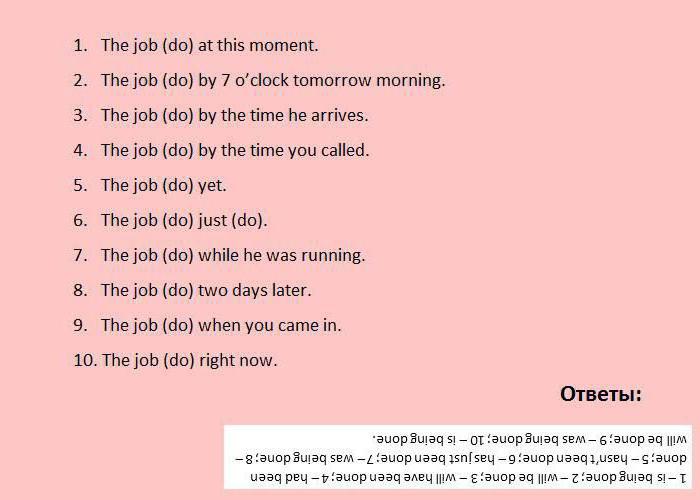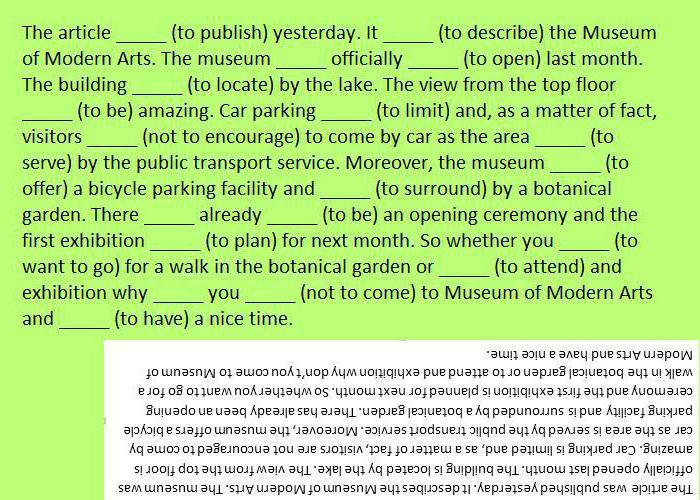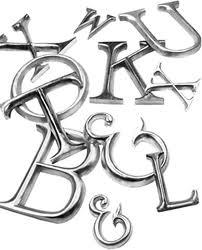Active Voice, Passive Voice: rules, examples. Active and passive voice in English
Today, we will learn how to construct phrases in such a way as to emphasize the impact on any animate or inanimate object.
The article contains explanations of the rules and exercises.
Active, Passive Voice in English: definition
What is active and passive voice? Active and Passive Voice - grammatical forms that determine what the object has to do with the action, or how the produced impact relates to the object in the phrase. Present in any language. English is known as:
- Active Voice.
- Passive Voice.
Active, or so-called valid,the pledge is used most often: the author of the implemented act is the subject, and the action itself is the predicate. The noun is active, because it itself makes an impact on someone or something.
Example:
Mike is doing his homework at the moment. "Mike is doing his homework at the moment."
Passive Voice - passive, or so-calledpassive voice. The noun is used as a complement, and the action is used as a predicate, the effect is exercised over someone or something.
Example:
The homework is being done by Mike at the moment. - Homework is done by Mike at the moment.
Usage Options
Passive voice too complicates the perceptionso excessive use of such a grammatical form is not very welcome. However, there are separate options, when one can not do without the use of a passive voice:
- The author of the carried out act is unknown (the act was carried out anonymously, it is not clear who or what effect was made):
This book was ripped yesterday. - This book was torn yesterday.
- The author of the impact is not significant (the person who committed the impact is not important):
The project will be finished by tomorrow. - The project will be finished tomorrow.
- The author of the action is already clear (it is obvious from the context):
The burglar was arrested last month. "The burglar was arrested last month."
- We are worried about the action itself, but not the author (in the headlines of news and announcements, when we are interested in what happened, but not who arranged it):
The jazz concert will be held on Tuesday. - The jazz concert will be held on Tuesday.
- The action can be carried out by anyone (in recipes, briefings):
The milk is heated and added to the dough. - Milk is heated and added to the dough.
- In the documents (in official announcements, abstracts):
This article is meant as an example of a research paper. - This article is presented as an example of research work.
Active and Passive Voice: Exercises
Task 1. Determine which usage rules are found in the following phrases, connect the sentence number with the rule letter. There may be several options, as can be seen from the picture.

Forms of passive voice
Consider the following forms of the Passive Voice. The predicate form of the predicate uses a part of the speech that designates the action "to be" in the third person of a single or plural number of a certain time (for example, "is", "are") and the main (semantic) part of speech denoting the effect, in the third form.
Part of the speech, indicating the action "to be"goes into the appropriate form, when the time in which the act of action is changing is changing. The sense part of the speech, indicating the impact, remains unchanged: it is always used as a participle of the past tense. In English, this form of the part of the speech denoting the action is called Past Participle or Participle II.
Parts of speech, denoting the action produced, are divided into two types: correct and incorrect. The latter are exceptions to the grammatical rule of the formation of certain temporal forms.
The third form of correct parts of speech denoting an action looks like the past tense: at the end is added - ed:
- to love - love;
- to play - played.
Wrong parts of speech, denoting an action,have a special third form, which must be remembered in each particular case. At the initial stage, you can use a special table of exceptions. But the most frequent parts of speech that denote the action that is produced are not correct, which are quickly remembered:
- to drink - drunk;
- to eat - eaten.
Part of the speech, which indicates the action "to be", inPassive voice passes through the same changes as the predicate in the real voice. A good clue to determine the timing of the impact is the adverbs of time (including adverbs of frequency).
In constructing questions, a part of the speech that denotesthe action performed is placed in front of the subject. When asking a question, think first about the effect that is being carried out, and then on the object or subject, over which it is carried out.
In negations, the particle "not" followsan auxiliary part of speech, denoting the action "to be". Do not make the most frequent mistake and do not put the main part of the speech, indicating the effect, to "not"! In this case, "not" comes before the main verb, it shares auxiliary and main verbs.
A Passive Bail and Times

As we can see, only part of the speech, which denotes the "to be" action, is changing. The main part of the speech, indicating the action, does not change.
Another important observation is that not all time groups are present in the passive voice. In the following cases, they must be replaced:
- Present Perfect Continuous is replaced by Present Perfect:
He has been cooking this meal since 5 p.m. - This meal has been cooked since 5 p.m.
Translation: He prepared this food from 17:00. - The food was prepared from 17:00.
- Past Perfect Continuous is replaced with Past Perfect:
Peter had been doing the research for 3 months. - The research had been done for 3 months.
Translation: Peter conducted the study for 3 months. - The study was conducted for 3 months.
- Future Continuous is replaced by Future Simple:
Tomorrow at 2 o'clock Helen will be cleaning this apartment. - This apartment will be cleaned tomorrow at 2 o'clock.
Translation: Tomorrow at two o'clock Helen will clean this apartment. - This apartment will be cleaned tomorrow at two o'clock.
- Future Perfect Continuous is replaced by Future Perfect:
Mike will have been driving the truck for 2 years by next week. - The truck will have been driven for 2 years by next week.
Transfer: Mike will drive the truck for two years by next week. - The truck will be used for two years by next week.
Task 2. Put the verb "do" in the desired form.

Replacement of collateral
If you want to replace Active Voice -Passive Voice, that is, to convert the phrase in an active voice into a passive form, you need to remember the features of the grammatical construction of the pledges.
In the phrase in the active voice, first comes the subject, in the second place - the predicate, and in the end follows the addition. In the passive voice, the addition takes the place of the subject.
Replacement Active Voice - Passive Voice is carried out in several stages:
- Determine which noun is a subject, and which complement:
Someone broke into their apartment yesterday.
- Determine in what time the effect is carried out:
In our version - Past Simple.
- At the beginning of the sentence, put the addition (instead ofsubject to), use the semantic part of the speech, indicating the impact, in the third form and place in front of her a part of the speech denoting the action "to be", in the necessary time form:
Their apartment was broken into yesterday.
The presence of two additions increases the number of options for constructing phrases in the passive voice:
Nick brought Kate a book. - Nick brought Kate a book.
- Kate was brought a book. - Kate was brought the book.
- A book was brought to Kate. - The book was brought by Kate.
Both variants are admissible, but it is better to use the form where the subject is an animated pronoun.
Task 3. Which pledge is preferable to use in the following cases: Active Voice, Passive Voice?

Prepositions "by" and "with"
Supplements are used in conjunction with these prepositions, when it is necessary to mention who the author of the action is and in what ways the influence is exercised.
The preposition "by" indicates the author (animate or inanimate person), which affects the object:
Sherlock Holmes was created by Sir Arthur Conan Doyle. - Sherlock Holmes was created by Sir Arthur Conan Doyle.
The preposition "with" indicates the ways in which (with auxiliary materials or tools) the effect is performed:
The soup is stirred with a spoon. - Soup interfere with a spoon.
The use of these prepositions is optional, except for questions beginning with the words “who” (by whom?) And “what” (with what?).
Who was Hercule Poirot created by? - Who created Hercule Poirot?
What was the fire caused by? - What caused the fire?
In the official style of speech, often prepositions are put at the beginning of the phrase:
Caused by fire - What caused the fire?
By whom was Hercule Poirot created? - Who created Hercule Poirot?
With what is the soup stirred? - What is the problem with soup?
Task 4. Put the verbs in the desired form Active and Passive Voice.

Modal verbs
How do they work? the Passive Voice and modal verbs - let's look further. Modal verbs are never used.independently, but only in combination with the part of speech denoting the effect produced, in an indefinite mood. If they are present in the description of the impact, in the passive voice, the part of speech denoting the impact produced is converted:
modal verb + "be" + Participle II
She might start research in July. (She may begin research in July.) - Her research might be started in July.
We should fill in that form by hand. (We must fill out this form by hand.) - That form should be filled in by hand.
If the phrase contains the following parts of speech, indicating the impact:
- to hear (hear);
- to help;
- to make (in the meaning of "forcing");
- to see,
after the main and auxiliary verbs there is another one in the indefinite mood (with the particle “to”):
I was made to clean the house. - I was forced to clean the house.
Mary will be helped to bake this cake. - Mary will help bake this cake.







